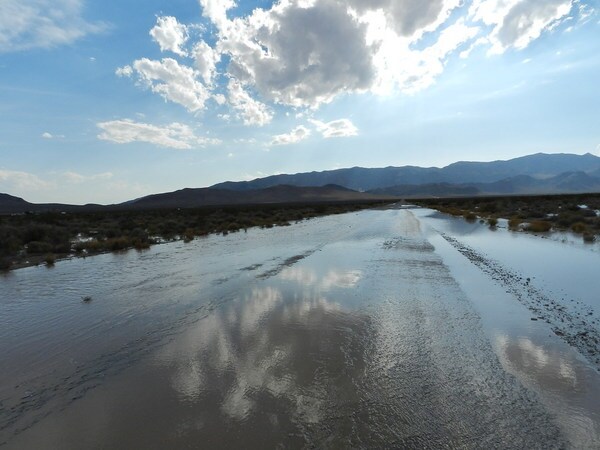Hidden Hills Solar Site Becomes Lake

Lake Hidden HIlls on the site of a proposed BrightSource power plant. | Photo courtesy Basin and Range Watch
BrightSource's proposed 500-megawatt Hidden HIlls Solar Electric Generating Planthas been having some water problems. The project site, on 3,277 acres of private land in Inyo County just south of Pahrump, Nevada, sits atop an increasingly oversubscribed aquifer. In the mid-20th Century, the Pahrump Valley held free-flowing springs and artesian wells. As development grew, those springs dried up, and residents now have to drill their wells deeper every few years. People are starting to worry about the nearby Stump Spring Area of Critical Environmental Concern drying up.
It's in this setting that BrightSource proposes to use 148 acre-feet of water per year for its Hidden Hills power towers, and the firm has been arguing over aquifer structures, negotiating over buying out water rights, disagreeing with state hydrologists and fending off angry locals who claim that much pumping will just make things worse in the valley. It's not hard to imagine BrightSource execs just wishing really hard that there was more water on the site.
If they did, they wished a little too hard.
On July 23 a monsoonal storm dumped rain on the vicinity of Pahrump -- a bit less than a tenth of an inch in town, perhaps significantly more in the surrounding mountains. Swelled by the rain, a flash flood headed out of Stump Spring toward the project site across the state line. Before long the floor of the valley was covered in a few inches of water.
This isn't an uncommon occurrence in the Mojave, but this flood had witnesses: biologists from the Nevada watchdog group Basin and Range Watch, who've been following the progress of the Hidden Hills Project. They shot the photo above and posted video of the flash flood on their Facebook page.
Sadly, the flood won't help the water shortage in the valley much if at all. What it might do, though, is cause agency soil scientists to look extra closely at BrightSource's design for their heliostat pylons. Every bit of soil in the Mojave is where it is because either a windstorm, a flash flood or a landslide put it there, and drilling poles into that soil puts those poles at the mercy of the forces that moved the soil there in the first place. A good flood after the plant is built, and BrightSource may find itself with 50,000 heliostats pointing the wrong way.
BrightSource has had similar problems at its other sites. A document BrightSource submitted to the California Energy Commission in October 2007 describing their proposed Ivanpah solar plant, now under construction south of the Hidden Hills site, stated confidently:
Flooding is not a hazard of concern at the Ivanpah SEGS site. According to the Federal Emergency Management Agency (FEMA), the site is not within either the 100- or 500-year flood plain.
On July 5, 2011 a flash flood raced through the Ivanpah site as construction proceeded. According to eyewitness reports, the flood tore out a flood control berm and moved several pieces of heavy equipment, leaving utility buildings onsite surrounded with more than a foot of water. It was a bit of egg on BrightSource's face in a year when Ivanpah's tortoises were leaving quite enough egg there already.
So BrightSource has every reason to take this week's Hidden Hills flood very seriously indeed. And if BrightSource execs are still hanging onto that monkey's paw they used to wish for more water at Hidden Hills, they should probably throw it away.
ReWire is dedicated to covering renewable energy in California. Keep in touch by liking us on Facebook, and help shape our editorial direction by taking this quick survey here.


